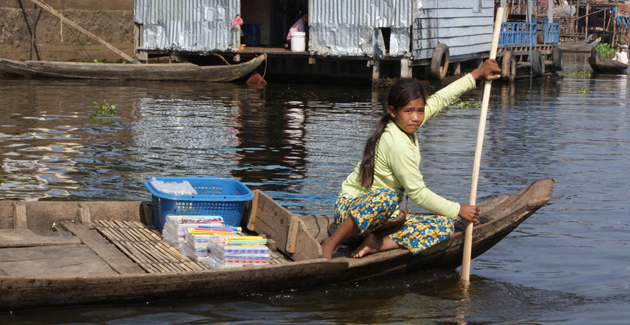Business-focused adaptation: climate proofing agricultural infrastructure


Adaptation context
Cambodia is highly vulnerable to the impacts of climate change and variability, in particular due to the high dependence of its economy on climate-sensitive sectors, and low adaptive capacity of its populations. Agriculture and water resources management are the most important pillars of the economy, with 84% of the population relying on agriculture for their livelihood. The country’s agricultural production system is dependent on the annual flooding and recession of Tonle Sap Great Lake, and is therefore particularly sensitive to potential changes in local climate and monsoon regimes. Rural infrastructure including roads, water supply, and sanitation, suffers from the impacts of floods and cyclones. Weather and climate data are not easily accessible and monitoring sites are insufficient for effective early warning, meaning rural residents rely largely on word of mouth to ready themselves for floods and other extreme climate events. Cambodia’s rural residents and critical basic infrastructure remain vulnerable to regular and costly weather shocks that undermine growth and development.
Project overview
Agriculture remains the dominant sector in the Cambodian economy contributing 32% of gross domestic product and employing 60% of the workforce, while 80% of the population depends on the sector for their livelihood. The agriculture sector has been one of the main engines of economic growth achieving steady growth over the past 10-years. Within agriculture, rice accounts for over 90% of the cropped area, the production from which is mostly consumed domestically. The rice subsector accounts for about 50% of the national agriculture, forestry and fisheries output. The Government of Cambodia (government) considers the rice subsector as an opportunity for socio-economic development and articulated its intentions in the Rice Policy to transform Cambodia into a “rice basket‟ and a major rice-exporting country. In this regard, the government has set three important objectives for 2015: (i) the paddy surplus will be over 4.0 million tons, (ii) milled rice exports will be at least 1.0 million tons,4 and (iii) Cambodia will be recognized internationally as a rice exporting country.
Cambodia reported a paddy surplus estimated at 3.3 million tons in 2010. Despite the surplus, nearly one quarter of the provinces face food deficits because of limited marketing channels and distribution infrastructure. Price fluctuations across provinces are frequently observed due largely to supply and demand imbalances and the movement of unprocessed paddy to Thailand and Viet Nam after each harvest. Eleven per cent of all households are considered food insecure, with many facing a deficit for one to two months each year. This figure rises during the dry season to an estimated 18%. Furthermore, 90% of all food insecure households are found in rural areas. Given its dominant position in the economy, transforming the rice subsector from being subsistent into a commercially oriented one is a strategic option for Cambodia as it provides the best opportunity to improve national food security, expand rice export, and as a result reduce poverty. These twin objectives of food security and export expansion will be mutually reinforced by paddy surpluses being marketed more increasingly within the country and on international markets. However, to achieve this outcome, major critical binding constraints must be addressed.
Challenges
- A legal and regulatory foundation that enables rice commercialisation is lacking
- Use of land and water resources for paddy production is suboptimal
- Capacities of post-harvest infrastructure are inadequate to handle increasing volumes of paddy.
- Quality of Cambodian rice is inconsistent
- Paddy production is increasingly vulnerable to the changing climate.
Key messages
To address climate change impacts in the Project areas, the PPCR funds will be used to:
- Improve water use efficiency through the upgrading of irrigation infrastructure designs toaccommodate more rapid flow of flood water induced by climate change – essentially by increasingcapacities of reservoirs, of delivery and drainage canals, of off-take and water management structures,and by imparting knowledge on climate resilience to those responsible for operating the irrigationfacilities.
- Demonstrate the benefits from land leveling to conserve water and improve irrigation water useefficiency (an essential adaptation strategy to cope with drought and flood).
- Undertake a feasibility study, design and pilot test a weather-indexed crop insurance scheme to assistfarmers to reduce climate risk associated with rice production. The scheme will be piloted in threeprovinces (Battambang, Kampong Thom, and Prey Veng) to test its application under local conditions.
- Assist in building the capacities of millers to accommodate the seasonal fluctuations imposed as aresult of climate change into their milling operations by improved stock management and efficienciesof mill operations.
Desired outputs
- A conducive legal and regulatory environment established to facilitate climate resilient rice commercialisation
- Agricultural land-use zoning improved
- Climate resilient rice value chain infrastructure developed
- Enhanced rice value chain support services
- Weather-indexed crop insurance (WICI) piloted
- Efficient Project Management and Implementation
Tasks complete
- Increased resilience of households, communities, businesses, sectors and societyto climate change and climate variabilitythrough investments in irrigation subprojectsbeing rehabilitated and climate proofed.
- Climate responsive investment approachesimplemented through land leveling asadaptation demonstrations being conducted ineach irrigation subproject.
- Strengthened climate responsive developmentplanning.
- Strengthened adaptive capacity through millmanagement training initiatives that integrateclimate change concerns.
- Strengthened adaptive capacity through millmanagement training initiatives that integrateclimate change concerns.
- Improved institutional framework in placethrough the adoption of sector developmentprogram approach encompassing policy andinstitutional reform and appropriatelycoordinated climate resilient investments.
(0) Comments
There is no content